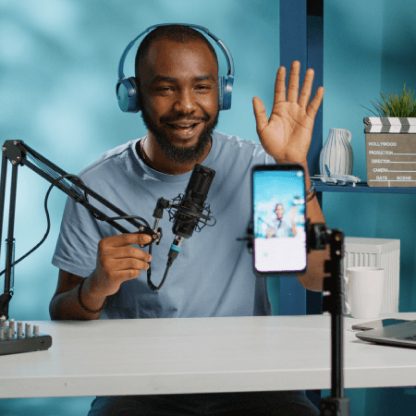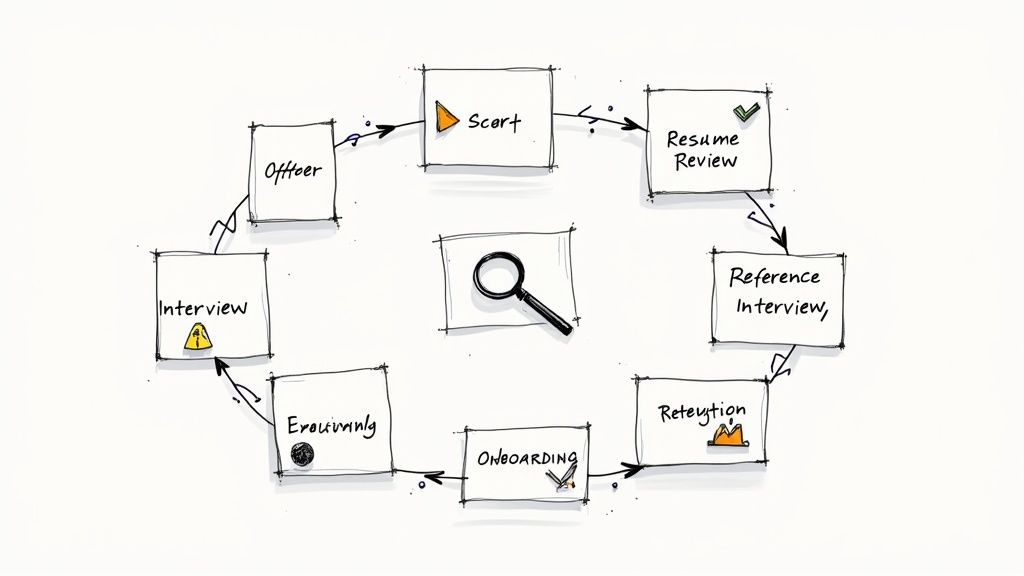So, what exactly is an on-demand video interview?
Imagine getting a set of interview questions sent directly to you, which you can answer and record on your own time. That’s the core idea. It’s like a professional video voicemail—there's no live interviewer on the other end, giving you the freedom to tackle it whenever and wherever you feel most prepared.
Understanding the Asynchronous Interview Process
At its heart, an on-demand interview—often called an asynchronous interview—flips the old-school hiring model on its head. Forget the back-and-forth emails trying to coordinate schedules for a live call. Instead, companies send you a link to a platform where the questions are waiting, one by one.
This approach puts you, the candidate, in the driver's seat. You get the invitation, find a quiet spot, test your camera, and log in when you're truly ready. You'll then face a series of questions, usually with a little time to think before the recording kicks in.
For employers, it's a game-changer. They can consistently screen a much larger pool of applicants without the logistical nightmare of scheduling. It helps them get a real sense of your communication style and personality right from the start.
The Candidate and Recruiter Experience
For the candidate, the whole process is pretty straightforward. It usually breaks down like this:
- The Invite: It starts with an email containing a unique link to the interview platform.
- The Setup: You get to pick a quiet, well-lit space and do a quick tech check before you even start. No surprises.
- The Recording: Once you begin, questions appear one at a time. You'll typically have 30-60 seconds to think and then 1-3 minutes to record your answer.
- The Submission: After the last question, you just hit submit, and your interview is sent straight to the hiring team.
On the recruiter's side, the workflow is just as simple. They can watch submissions whenever it works for them, easily share them with colleagues for a second opinion, and compare candidates fairly since everyone answered the exact same questions.
The shift to this format has been massive. By 2025, video interviews were already a dominant force in hiring, with roughly 79% of hiring managers using the technology. What's more, 60% of recruiters now use video interviews as a standard part of their process, regardless of the job’s location. This isn't just a trend; it's a fundamental change in how hiring gets done. You can dive deeper into these hiring stats to see how the landscape has evolved.
The real value of an on-demand video interview is its ability to dissolve time constraints for everyone involved. It respects the candidate's schedule while giving the hiring team a scalable way to evaluate talent fairly and consistently.
The Real Pros and Cons of This Interview Format
Like any tool in the hiring toolkit, an on-demand video interview has its own set of trade-offs. It's not a silver bullet for every role or company, but really getting to grips with its strengths and weaknesses is key for both recruiters and candidates to get the most out of it. On one hand, you get a massive boost in efficiency and flexibility. On the other, you introduce some new hurdles in communication and genuine evaluation.
For hiring teams, the biggest win is the sheer efficiency. The logistical nightmare of playing calendar Tetris across different time zones? Gone. This frees up a huge amount of time, letting recruiters focus on what really matters: figuring out if a candidate is the right fit.
This infographic gives you a quick visual breakdown of the efficiency gains companies are seeing.
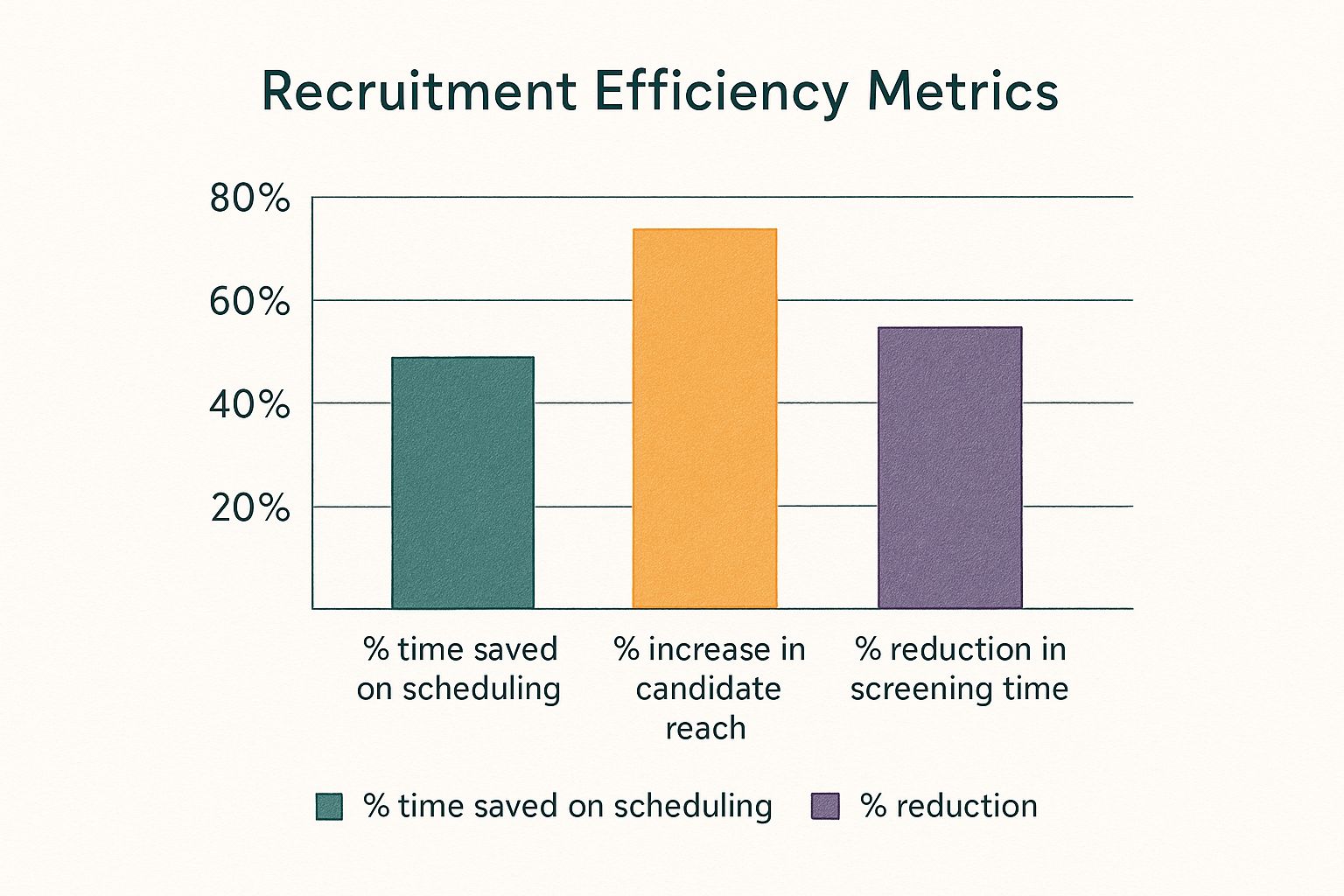
The numbers don't lie. Organizations using this format are slashing the time they spend on scheduling and initial screening, all while opening the door to a much wider, more global talent pool.
Now, let's dig into a more detailed breakdown of the pros and cons for everyone involved.
On Demand Video Interview Pros vs Cons
| Aspect | Advantages (Pros) | Disadvantages (Cons) |
|---|---|---|
| Scheduling & Flexibility | Candidates record on their own time, reducing stress and eliminating the need to take time off work. Recruiters can review submissions anytime, anywhere. | The lack of a set appointment can sometimes lead to procrastination for candidates. |
| Talent Pool Access | Geography is no longer a barrier, allowing companies to tap into a global talent pool and find highly specialized skills. | Technical barriers, like poor internet access, can unintentionally exclude some otherwise qualified candidates. |
| Evaluation & Bias | Every candidate gets the same questions in the same format, creating a more standardized process that can help reduce unconscious bias. | Without live interaction, it's harder to assess soft skills, like a candidate's ability to think on their feet or build rapport. |
| Candidate Experience | Candidates get more control and can prepare in a comfortable environment. They can re-record answers if they stumble. | The experience can feel impersonal and one-sided, like talking to a wall. This can increase anxiety for some and make it hard to show personality. |
| Recruiter Experience | Allows for efficient screening of high volumes of applicants. Reviewing recordings can be done collaboratively with the hiring team. | Recruiters can't ask spontaneous follow-up questions to dig deeper into an interesting answer. |
| Cost & Time | Drastically reduces time spent on initial screening interviews and eliminates travel costs for both parties. | Initial setup and subscription costs for the video interviewing platform. |
Ultimately, while the benefits are compelling, it's crucial to acknowledge the drawbacks to create a process that's both efficient and human.
The Downside: What Gets Lost on Camera
The asynchronous nature of these interviews—the fact that you're not talking in real-time—is where the biggest challenges pop up. Without the immediate back-and-forth of a live conversation, it can be incredibly tough to build a personal connection.
The biggest hurdle in an on demand video interview is the absence of human chemistry. Candidates can't read the room or adjust their approach based on an interviewer's reactions, and recruiters miss out on spontaneous, unscripted interaction.
Candidates often say it feels like they’re talking into a void, which makes it difficult to let their personality shine through. For recruiters, the inability to ask immediate follow-up questions means they might miss a golden opportunity to explore a candidate's response more deeply. Something as simple as a flat delivery or bad lighting could also create an unfairly negative impression that has nothing to do with a person's actual qualifications.
So, how do you fix this? To get around these issues, companies should provide crystal-clear instructions and even offer a chance for candidates to do a practice run. For their part, candidates should prepare by practicing their answers out loud, making sure they come across as engaging and authentic—even when there’s no one on the other side of the screen. A little preparation on both sides can go a long way in bridging the gap created by the screen.
How Candidates Can Prepare to Impress
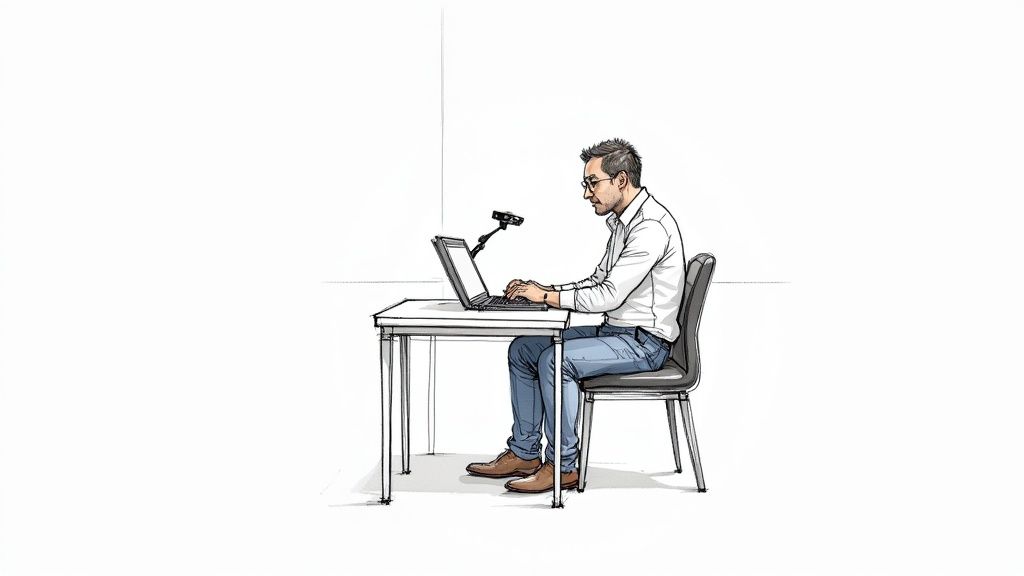
When you're facing an on-demand video interview, it's not just about what you say, but how you show up. Unlike a live chat, you have total control over your surroundings. This is a huge advantage, so use it to craft a first impression that screams professionalism and confidence from the second your video starts.
Think of it as setting the stage for your own one-person show. The goal is to make sure the tech works perfectly and all distractions are gone. That way, your personality and skills get the spotlight they deserve.
Set Your Stage for Success
The space you record in says a lot about you before you utter a single word. A clean, organized background tells the recruiter you're professional and pay attention to detail. On the other hand, a cluttered or busy space can be a major distraction and leave a sour first impression.
Here’s a quick checklist to get your stage ready:
- Background Check: Pick a neutral, tidy background. A simple wall, a neat bookshelf, or a single piece of art all work great. Definitely avoid any high-traffic areas in your home.
- Lighting is Key: Make sure you're facing a light source, like a window or a good lamp. This keeps your face from being cast in shadows and makes you look far more engaged and professional.
- Eliminate Noise: Give your family or roommates a heads-up about your recording time to avoid surprise interruptions. Shut the windows, silence your phone, and turn off every last notification on your computer.
One of the most common mistakes is skipping over the small stuff. Always do a quick test run by recording a short video of yourself. What you see on that playback is exactly what the hiring manager will see.
This little bit of prep helps you catch and fix any problems—like bad lighting or a weird camera angle—before you hit record for real.
Master Your Tech and Your Message
Nothing kills an interview vibe faster than a technical glitch. It's stressful and can throw off an otherwise stellar performance. Before you even think about recording, do a full tech check. Make sure your camera and mic are working correctly within the interview platform itself. A stable internet connection is also non-negotiable; if your Wi-Fi is spotty, plug directly into your router with an Ethernet cable.
With the tech handled, it’s time to focus on what you're going to say. The on-demand format gives you a golden opportunity to deliver thoughtful, well-organized answers. Don't even think about winging it.
- Anticipate the Questions: Dig into the job description and try to predict the questions they'll ask about your experience, skills, and past behavior in work situations.
- Structure Your Answers: Use a simple framework like the STAR method (Situation, Task, Action, Result) to tell clear, compelling stories about what you've accomplished. It keeps your answers focused and impactful.
- Practice, Don't Memorize: Run through your answers out loud. Your goal is to sound natural and conversational, not like you’re reading from a script. Also, keep an eye on the time limits the platform gives you for each answer.
Getting this prep work done will boost your confidence, freeing you up to deliver your absolute best performance. For more great advice, you should check out our complete guide on mastering your on-demand video interview with pro tips for success. It’s packed with insights to help you make a fantastic impression.
Common Mistakes That Can Cost You the Job
Even the sharpest candidates can get tripped up by an on-demand video interview. It’s a whole different ballgame than a face-to-face meeting, and the unique format can bring out mistakes you wouldn’t normally make. Knowing what these common pitfalls are is the first step to sidestepping them entirely.
The biggest mistake? Treating it like an open-book test. It is painfully obvious when someone is reading their answers from a script just out of view. Your eyes start darting back and forth, your voice goes flat, and any spark of personality you have is instantly extinguished.
Don't write a script. Instead, jot down a few bullet points to keep you on track. This simple trick allows you to speak naturally and conversationally, letting your real communication style shine through.
Presentation and Technical Blunders
It’s not just about what you say—it’s about how you present yourself. Little oversights in your environment or your tech setup can sour a recruiter’s impression before you even get through your first answer. These mistakes scream "unprepared" or show a lack of attention to detail.
Here are some of the most common stumbles we see:
- Poor Framing and Lighting: A camera angle pointing up your nose or a face lost in the shadows is incredibly distracting and just looks unprofessional.
- A Messy or Busy Background: A pile of laundry, an open door with people walking by—anything in the background pulls the focus away from you.
- Inappropriate Attire: Rolling up in a hoodie or a t-shirt sends a clear message: you're not taking this seriously. Dress like you would for an in-person interview.
A huge red flag is failing to test your technology beforehand. A glitchy camera or a microphone that cuts out can completely derail your interview, and it reflects poorly on your ability to prepare.
The High Cost of Tech Issues
A technical problem isn’t just a small hiccup; it can be an absolute deal-breaker. Recent data shows just how stressful and high-stakes this part of the process is for candidates. While almost half of job seekers like the flexibility of video interviews, a staggering 70% of candidates report they’ve lost out on a job because of a tech issue.
On top of that, about 25% find them more stressful than a traditional interview, often because they’re terrified something will go wrong with the technology.
Dodging these common mistakes is your ticket to making a great first impression. To see how companies are using this format from their side, check out our guide on smart hiring with one-way and on-demand interviews.
How Companies Can Improve the Candidate Experience
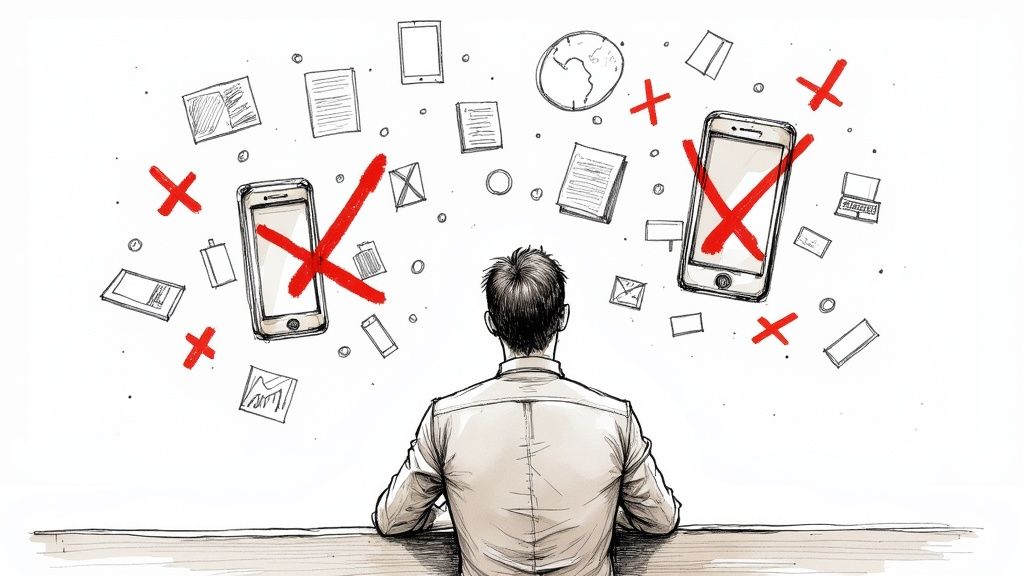
Let's be honest. For employers, the real power of an on-demand video interview isn't just about screening more people faster. It's about creating a respectful, positive experience that makes top candidates want to work with you.
A poorly handled process can feel cold and impersonal, turning off great talent before you've even had a real conversation. The last thing you want is for your first impression to feel like a robotic pop quiz.
The key is to think less about pure efficiency and more about the human on the other side of the screen. This is your first handshake with a potential team member, and it starts with giving them crystal-clear instructions to set them up for success.
Creating a Fair and Transparent Process
In the world of hiring, clarity is kindness. Candidates are already nervous, and adding ambiguity just makes things worse. Your instructions should be detailed, covering everything from the tech setup to what your team is actually looking for.
- Set Clear Expectations: Be upfront about the purpose of the video interview, roughly how long it will take, and what happens next.
- Offer a Practice Round: Giving candidates a chance to test their camera and mic with a non-graded practice question is a small step that dramatically reduces anxiety.
- Establish Fair Time Limits: Make sure you're giving candidates enough time to both think and respond. Rushed answers rarely show you what someone is truly capable of.
- Be Transparent: Briefly explain your evaluation criteria. Just knowing they’re being assessed on communication or problem-solving helps candidates focus their answers.
This level of transparency shows you respect their time and effort, turning what could be a stressful test into a genuine opportunity to shine.
Crafting Better Questions and Training Your Team
The questions you ask are the heart and soul of the interview. It's time to ditch the generic queries that just invite rehearsed, cookie-cutter answers. Instead, design questions that dig into personality, critical thinking, and how someone might actually handle scenarios on the job.
A great on-demand video interview question doesn't just ask what a candidate did; it uncovers how they think. Focus on situational and behavioral prompts to see their problem-solving skills in action.
Finally, you have to prepare your hiring team. It’s absolutely essential to train evaluators on how to spot and mitigate unconscious bias. Using standardized scoring rubrics helps ensure every single candidate is judged on the same merits, creating a level playing field.
When you get this right, the impact is huge. Companies have reported slashing their time-to-hire by 50-70% and cutting recruitment costs by up to 50%. You can learn more about how to modernize your recruitment process with on-demand asynchronous interviews and see how to get there yourself.
Answering Your Top Interview Questions
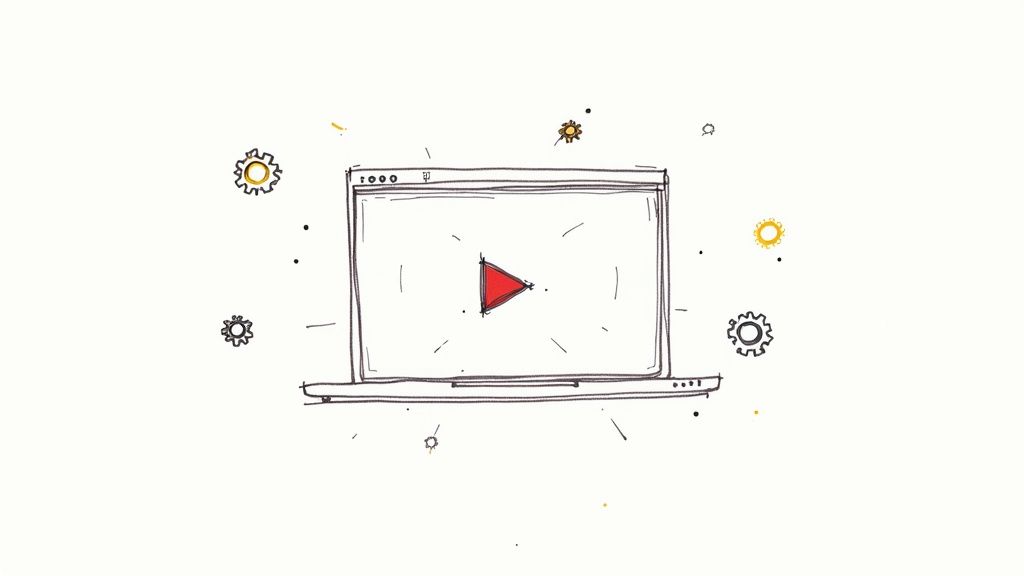
As on demand video interviews become a fixture in modern hiring, it’s only natural for some questions—and a bit of uncertainty—to pop up. Candidates and recruiters alike are still getting the hang of this format, trying to figure out the unwritten rules and best practices.
Let's clear the air. We’re going to tackle the most common questions head-on, giving you direct, practical answers so everyone can walk into the process feeling confident and ready.
How Do Companies Evaluate Recorded Answers?
This is a huge one for candidates: "Is a robot watching me?" While it's true some massive companies might use a sprinkle of AI for basic keyword spotting, the vast majority of businesses rely on real, live human beings. Your recorded interview is almost always reviewed by one or more people on the hiring team.
To keep things fair and consistent, companies usually lean on a structured evaluation process.
- Standardized Rubrics: Think of it like a scorecard. Evaluators use a rubric with predefined criteria, which might include things like your communication skills, the quality of your examples, technical know-how, and how well you seem to align with the company's values.
- Collaborative Review: These platforms are built for teamwork. They allow multiple people—like the recruiter, the hiring manager, and even a potential teammate—to watch and score your interview on their own time. This helps wash out individual bias and leads to a more well-rounded decision.
- Direct Comparison: Because every single candidate answers the exact same questions, recruiters can compare responses side-by-side. This makes it much easier to spot the truly standout answers and identify top performers in an objective way.
The goal isn't to play "gotcha" or catch you in a minor slip-up. It's about getting a clear, consistent sense of your qualifications and how you think on your feet. They’re looking for the substance of what you say, not a flawless Hollywood delivery.
Can I Re-Record My Answer if I Make a Mistake?
The short answer? It totally depends. This is one of the most variable parts of an on-demand interview, and it’s something the company should communicate clearly right from the get-go.
You'll likely run into one of these three scenarios:
- One and Done: Some companies set up their interviews to allow only a single take. The idea here is to capture a more spontaneous and authentic response, much like you'd give in a live conversation.
- Limited Re-takes: This is a more common and candidate-friendly approach. You might get one or two chances to re-record per question. It’s a nice safety net if you trip over your words or your neighbor's dog starts barking mid-sentence.
- Unlimited Re-takes: While pretty rare, some platforms might allow unlimited attempts. But be careful with this—spending forever trying to craft the perfect answer can make you sound robotic and over-rehearsed.
Pro Tip for Candidates: Always go in assuming you only have one shot. Prepare like you need to nail it on the first take. If you do get a do-over, use it to fix a major fumble, not to obsess over a tiny imperfection.
Will This Technology Replace Traditional Interviews?
This question is on a lot of people's minds, and the answer is almost certainly no. On demand video interviews aren't here to replace human connection. They’re designed to be a powerful enhancement to the early stages of the hiring process.
Think of it as the modern-day cover letter or a supercharged phone screen. Its main job is to help recruiters efficiently and fairly screen a large applicant pool to build a shortlist of high-quality candidates. It’s a solution for the logistical traffic jam at the top of the hiring funnel.
A typical hiring workflow with this tech folded in often looks like this:
- Step 1: Initial application screening.
- Step 2: An on demand video interview to get a feel for core skills and communication style.
- Step 3: Live interviews (either on video or in-person) with the top candidates for a real conversation and to assess cultural fit.
- Step 4: Final rounds and the offer.
This format is fantastic at identifying a strong group of contenders, but it simply can't replicate the dynamic, two-way conversation of a live interview. The final call almost always comes down to the personal connection and in-depth discussion that can only happen when people talk directly to each other.
Ready to make your hiring process up to 10 times faster? Async Interview provides a seamless on demand video interview platform that helps you identify top talent efficiently while ensuring a great candidate experience. Discover how Async Interview can transform your recruitment today.
